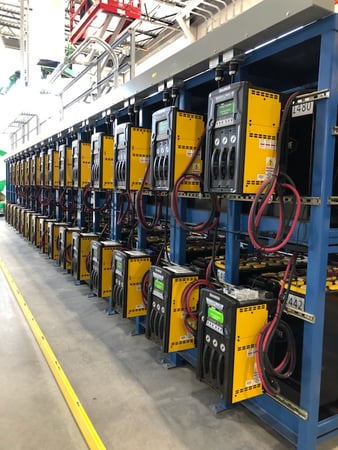 Has a forklift driver ever lost track of a truck somewhere in your facility, throwing off your productivity? If so, you’re not alone. It’s a dirty little secret that happens in many high-velocity facilities.
Has a forklift driver ever lost track of a truck somewhere in your facility, throwing off your productivity? If so, you’re not alone. It’s a dirty little secret that happens in many high-velocity facilities.
That’s because a high-velocity plant often has 40 or more forklifts with 2-3 shifts and dozens of drivers in a 24-hour period. So there’s a lot that can go wrong!
The truth is that small facilities have more leeway; a larger high-velocity facility needs data-driven management to reign in potential chaos and maintain productivity.
But with so many considerations in play, it can be hard to know where to begin and what to prioritize.
That’s why we wanted to recap the 5 most unmanageable forklift factors, along with a plan of action. Read on!
1. A forklift in motion…
Well-managed forklifts are constantly moving from one spot in a warehouse to the next – and with any moving vehicle, there is some sort of safety risk involved. Not only must forklift operators be careful when driving, fellow workers need to stay alert. Plus, changing a forklift’s battery can be a dangerous task as they are heavy and usually require special equipment.
And remember those lost forklifts? The next time ‘Joe’ forgets for a week where his forklift is parked, you’re well aware you’ve lost productivity. Another less quantifiable cost is the wrench that MIA forklift throws into your maintenance schedule. While that sounds minor, it can cumulatively cost you a lot of money. After all, if your forklift is not maintained in a timely fashion or on a strict schedule, you’ll need to replace your batteries and/or your trucks more frequently.
2. Refueling Requirements
Did you know that a forklift’s battery accounts for approximately 30% of the forklift’s total cost? Like any stand-alone unit, forklifts need to be properly recharged – whether that involves propane, hydrogen, or swapping of the batteries. That takes time, energy (figuratively and literally), and oversight.
For example, many plants charge the machine when it’s most convenient for the operator, rather than when it is required to best maintain the equipment. Forgetting to plug up during breaks, lunch or at the end of the day can significantly reduce the life of your forklift battery, negatively impacting your warehouse’s uptime and costs. It’s vital that an appropriate charging schedule is established – and maintained - from the start.
3. Multiple Operators
It’s no secret that people are innately different, which means that not all operators are alike. Most forklifts at high-velocity facilities have multiple operators, which creates variability and risk.
While some may operate the machines at a normal speed, others may like to live life a little on the wild side. It should come as no surprise that fast or careless operating negatively affects machine integrity and employee safety. Of course, some plants use controls, such as capping the top speed, but it’s hard to control every factor.
This uneven operating means it’s even more important to maintain your system using data, which leads us to the next factor…
4. Lack of coordinated data
Data can be one of the most unmanageable aspects of forklifts for larger facilities. Most plants don’t have the data they need to properly maintain their forklifts and to ensure they’re being utilized efficiently. Adding to the confusion, multiple systems are often not built to work together to provide a “big picture” view.
That’s why forklift power systems should be designed – and then maintained – using data. If everything isn’t created to work together optimally, you’re missing a huge piece of the puzzle – and your uptime and cost will be affected.
5. Lack of expertise
It takes specialized knowledge to optimize data for a large facility. While a small warehouse can get away with more “wiggle room,” a large plant requires an expert technician with engineering knowledge.
This is where everything comes together because a technical specialist uses data to implement the right maintenance. This allows your facility to transition from passively managed power (which can make you lose as much as $4k per forklift) to actively managed power.
It boils down to this: a high-velocity facility with 40 or more forklifts simply can’t cut costs and improve uptime without a skilled tech with specialized engineering knowledge.
Here at Concentric, the ‘right approach’ starts with assessing your company’s process and applications, followed by designing a power system and ultimately implementing it properly. As we learned from the five challenges discussed above, you should have a program that’s designed around and maintained by data, run by an expert technician and backed-up by an engineering team. The right power system will not only increase your supply chain uptime, but also your facility’s overall productivity.
 If you’re interested in learning more about how a power management option can work strategically for your high-velocity facility, we at Concentric would be happy to answer any questions. Feel free to get in touch!
If you’re interested in learning more about how a power management option can work strategically for your high-velocity facility, we at Concentric would be happy to answer any questions. Feel free to get in touch!


